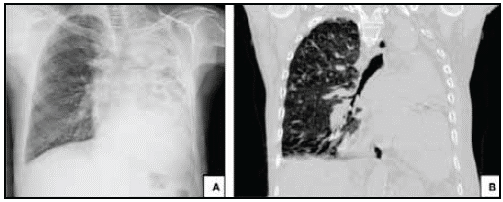A 69-year-old male with high blood pressure, 50% LVEF heart failure, oxygen-dependent chronic obstructive pulmonary disease, a heavy smoking history and treated pulmonary tuberculosis was admitted to the emergency room due to mMRC 4/4 dyspnea, productive cough with yellow sputum, non-quantified fever, and diminished breath sounds. A chest x-ray showed left-sided diffuse heterogenous radiopacity and a high-resolution CT revealed left fibrothorax.
Fibrothorax is defined as the sequela of intense pleural inflammation, causing thickening and fibrosis 1,2. Transforming growth factor-beta (TGF-|3) plays the most important role 3. It occurs most often as a complication of empyema and hemothorax, but also in pulmonary tuberculosis, connective tissue diseases, uremia, paragonimiasis, radiation therapy, asbestosis and with medications such as ergot alkaloids 2-4. It is diagnosed by imaging. Treatment may be pharmacological, using systemic corticosteroids, or surgical with decortication 2,5. It has been associated with lung cancer 6.

Figure 1 (A) AP chest x-ray showing diffuse heterogenous radiopacity of the left chest with associated ipsilateral loss of volume. Radiografía de tórax en proyección P-A. Evidencia radiopacidad difusa heterogénea del hemitorax izquierdo asociada perdida de volumen ipsilateral. (B) Coronal high-resolution CT in lung window projection showing loss of volume in the left lung with consolidation and varicose bronchiectases.

Figure 2 Chest computerized tomography image using an axial lung window. (A) and a mediastinal window; (B) sagittal mediastinal window; (C) showing left pleural thickening and calcifications. Free right pleural effusion. Mediastinal adenopathies. Cardiomegaly and precapillary pulmonary hypertension showing loss of left lung volume with consolidation and varicose bronchiectases.











 text in
text in 


